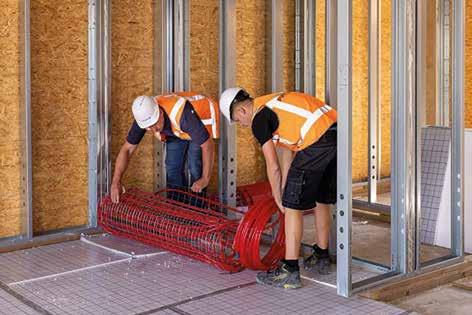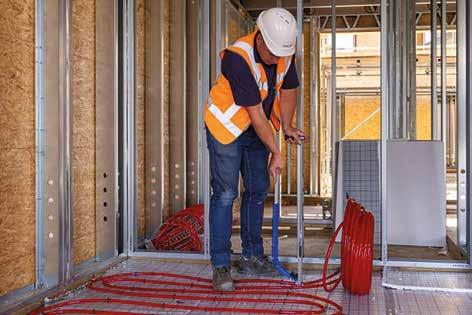
3 minute read
Prefabricated Underfloor Heating – The Future of Underfloor is Here!
Underfloor heating combines high comfort levels, low maintenance and excellent energy efficiency — for these reasons, such systems have become popular in many European countries. Listening to the feedback from investors, designers and installers, Pipelife has taken the next step by adding prefabricated underfloor heating to the product portfolio. Pipelife’s Ireland’s Technical Manager Michael Geary explains the solution and the advantages it offers throughout the construction process.
What Is Prefabricated Underfloor Heating By Pipelife
Advertisement
Pipelife’s prefabricated underfloor heating solutions entail a comprehensive service that covers everything from the design to the assembly and delivery of underfloor heating systems. The prefabricated mats and prefab manifold cabinets boast exactly the same customizability and benefits as standard hydronic underfloor heating products while speeding up the installation process 3-6 times.
The solution is particularly advantageous for large-scale building projects, such as residential complexes, row houses, hospitals, hotels and nursing homes.
COMBINING END-TO-END SERVICE WITH PREFAB
From finding qualified workforce and meeting project deadlines to keeping up with increasing customer expectations and regulations, the buildings sector currently faces plenty of challenges. Developing endto-end services is a way building material suppliers can help mitigate these issues, and prefabrication is one of the areas with large yet relatively untapped potential.
“In many countries, like in the Netherlands for example, there is a growing demand for prefabricated underfloor heating mats,” says Michael. “We wanted to combine such a product with other services that we have been offering to our clients, such as design support and preassembled manifolds, creating a unique, all-inclusive offer on the market.”
Achieving Higher Installation Efficiency And Reliability
Construction projects are frequently delivered late and exceed their original budget. Prefabrication allows avoiding unplanned costs while taking significantly less time than traditional on-site construction.
If installing standard underfloor heating in a room of 20 m2 typically takes 20-30 minutes, prefabrication allows completing the same task in just 5-7 minutes — offering major gains for contractors as well as investors.
Furthermore, Pipelife’s prefabricated mats and manifolds are assembled in factory-controlled environments by trained professionals using only top-quality materials. The process eliminates risks of typical installation errors, such as deviations from the drawing plan or incorrect connections.
This way, prefabrication not only allows achieving higher reliability and excellent service life of the installed heating system but can also help optimize supervision onsite.
“As the whole system is produced, preassembled and delivered by a single supplier, the reliability from the technical standpoint is very high — facilitating and speeding up the commissioning,” explains Geary.
Offering Full Design Support
Underfloor heating systems are known for their long, maintenance-free service life. If functionality issues arise, they often can be traced back to poor design. The optimal heat output of each system must be carefully calculated and depends on multiple factors, such as the insulation and age of the building, heating zones desired, heat sources available, and even the selected floor finish.
As designing heating systems requires in-depth expertise and is time-consuming, Pipelife offers full design support as part of the solution. With a design team that has more than a decade of design experience and in-depth industry background, almost 300 design projects were completed last year alone.
The service saves project designers hours of tedious work. A fully tailored heating system design, considering the unique conditions and requirements of the particular project, is prepared and sent to the customer in just a few days.
“This way, we can ensure the best technical solution for our clients while saving time for project designers — who can focus on other tasks or even take on more projects,” sums up Geary. “As time pressure in the building sector keeps increasing, just as expectations of project safety and quality, such a service is a win-win solution.”
New Opportunities For Installers
Reports show an acutely growing shortage of skilled workers in the EU, slowing down the completion of the started projects and, if unresolved, impeding future growth of the construction sector.

Prefabricated products can be installed in a shorter time and by fewer people, compensating for the lack of high-profile installers many countries in Europe are struggling with.
“Nowadays, installers are typically paid either per project completed or per square meter installed. As the demand for qualified installers is high, they often have to decline requests. Our solutions enable installers to accept more projects as they can complete their tasks faster,” explains Geary.
The new prefabricated underfloor heating solutions do not eliminate the need for skilled construction workers on-site, as their expertise is still required to carry out specific tasks like connecting the mats to a manifold and pressure testing.

“Our prefabricated underfloor heating is tailored to each project; these are not generic products that will be available in depot stores,” Geary asserts. “The installation process is faster and simpler compared to standard underfloor heating systems, but it requires supervision and assistance from qualified specialists.”
UP TO 30% HIGHER COST EFFICIENCY
As construction material costs keep rising, the profit margins for investors and contractors have eroded over the last few years. Prefabrication is a way to address the inefficiencies that standard construction entails and minimize material waste, helping alleviate the cost increases.
The data from already commissioned prefabricated hydronic underfloor heating projects in the Netherlands, Bulgaria and Serbia show impressive cost-efficiency improvements compared to traditional underfloor heating systems.
“Considering the time savings and efficiency gains throughout each step of construction, the overall cost savings are 20-30%,” says Geary. “Our completed prefab projects clearly show how stepping away from the standard approach can open up new opportunities in the buildings sector.”
Micheál O’Connor, Managing Director, Dornan Group.









